R&B has undergone significant evolution, blending with genres like funk, hip-hop, and pop. Key figures such as Aretha Franklin and Stevie Wonder have shaped its rich history. The genre explores themes of love and empowerment while adapting to cultural shifts. Today, R&B artists face challenges in a competitive landscape, yet continue to innovate and resonate with diverse audiences.
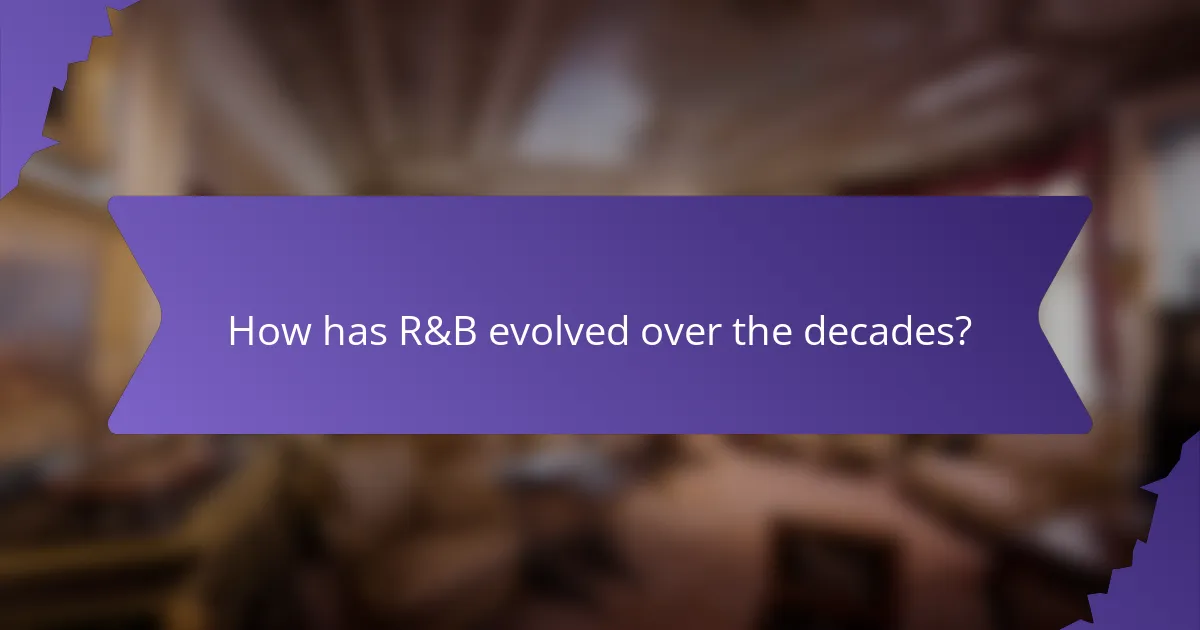
How has R&B evolved over the decades?
R&B has evolved significantly over the decades, blending with various genres and reflecting cultural shifts. In the 1950s, R&B emerged from blues and jazz, characterised by strong rhythms and emotive vocals. The 1970s introduced funk and soul influences, with artists like Marvin Gaye and Aretha Franklin shaping the genre. The 1980s and 1990s saw the rise of New Jack Swing and contemporary R&B, featuring artists such as Whitney Houston and Boyz II Men, who incorporated pop elements. In recent years, R&B has further blended with hip-hop and electronic music, showcasing artists like Frank Ocean and H.E.R., who push creative boundaries. This genre’s adaptability continues to resonate with diverse audiences, highlighting its enduring legacy.
What are the defining characteristics of classic R&B?
Classic R&B is defined by its soulful melodies, rhythmic grooves, and emotional lyricism. Key characteristics include strong vocal performances, a focus on love and relationships, and the blending of gospel, blues, and jazz influences. The genre often features lush instrumental arrangements and prominent bass lines, creating a rich sound. Notable figures like Aretha Franklin and Marvin Gaye exemplify these traits, showcasing the genre’s ability to convey deep emotions. Classic R&B continues to influence contemporary music, highlighting its lasting impact on the musical landscape.
Which key events marked the transformation of R&B in the 1980s?
The transformation of R&B in the 1980s was marked by the emergence of new sounds and influential artists. Key events include the rise of synthesizers, which introduced a fresh electronic sound, and the crossover success of artists like Prince and Whitney Houston. The genre also began to blend with hip-hop, as seen in tracks like “Rapper’s Delight.” Additionally, the establishment of music videos as a promotional tool transformed how R&B artists reached audiences. These changes collectively reshaped R&B, making it more mainstream and diverse.
How did the rise of hip-hop influence contemporary R&B?
The rise of hip-hop significantly transformed contemporary R&B by infusing it with new rhythms, lyrical styles, and cultural narratives. Hip-hop’s influence introduced a more conversational tone in songwriting, allowing R&B artists to explore personal and societal themes more deeply.
Collaborations between hip-hop and R&B artists became common, blending genres and expanding audience reach. Notable figures like Usher and Beyoncé incorporated hip-hop elements, enhancing their appeal and chart performance.
The production techniques in R&B evolved as hip-hop beats and sampling became prevalent, creating a fresh sound that resonated with younger listeners. This genre blending has led to the emergence of subgenres like hip-hop soul, which combines melodic R&B vocals with hip-hop instrumentation.
As a result, contemporary R&B now reflects a diverse musical landscape, showcasing the lasting impact of hip-hop on its evolution and cultural relevance.
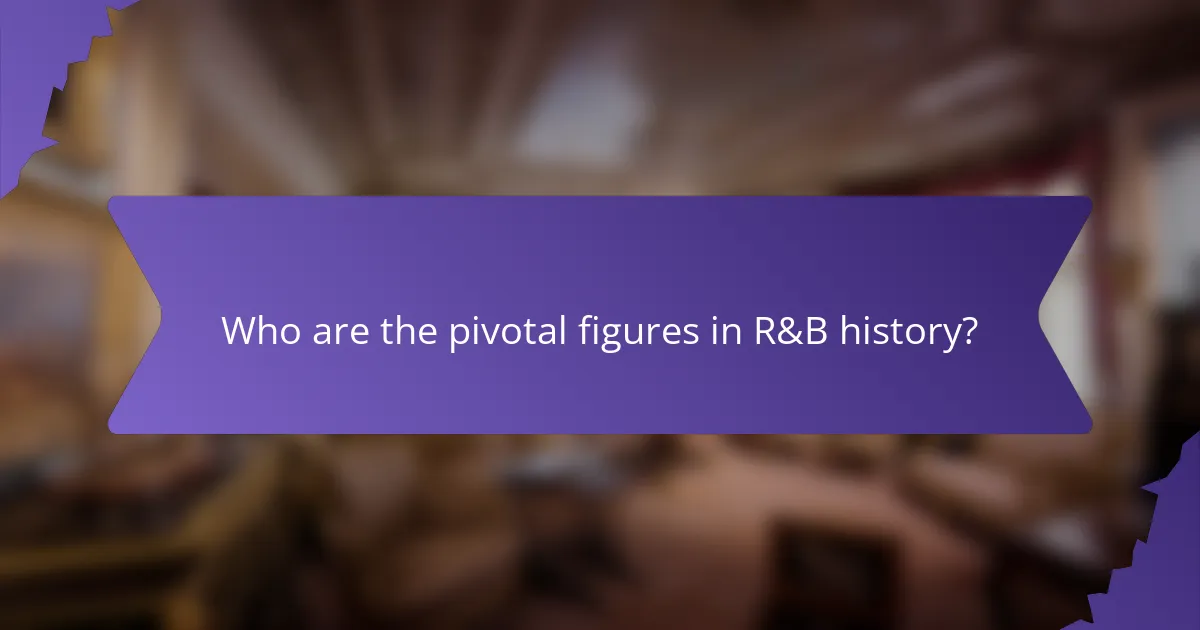
Who are the pivotal figures in R&B history?
Pivotal figures in R&B history include artists like Ray Charles, Aretha Franklin, and Stevie Wonder. Their contributions shaped the genre’s evolution and influence. Ray Charles blended gospel and blues, creating a unique sound. Aretha Franklin, known as the “Queen of Soul,” brought emotional depth and power to R&B. Stevie Wonder expanded the genre with innovative production and songwriting. Other significant figures include Marvin Gaye, whose socially conscious themes resonated widely, and Whitney Houston, who brought R&B to a global audience with her vocal prowess.
What impact did artists like Aretha Franklin and Marvin Gaye have on the genre?
Artists like Aretha Franklin and Marvin Gaye significantly shaped R&B by infusing it with emotional depth and social consciousness. Franklin’s powerful vocals and gospel influences brought a new level of expressiveness, while Gaye’s innovative production techniques and lyrical themes addressed issues like love and civil rights. Their contributions helped R&B evolve into a genre that not only entertained but also inspired social change. This blend of artistry and activism established a foundation for future musicians, making their impact enduring and influential.
How have modern artists like Beyoncé and Frank Ocean redefined R&B?
Modern artists like Beyoncé and Frank Ocean have redefined R&B by blending genres and introducing innovative themes. They incorporate elements from pop, hip-hop, and electronic music, creating a diverse sound that resonates with a broader audience.
Beyoncé’s work, particularly in albums like “Lemonade,” showcases deeply personal narratives and social commentary, pushing the boundaries of traditional R&B. Frank Ocean’s “Blonde” exemplifies unique storytelling and experimental production, emphasizing emotional depth and authenticity.
Both artists challenge conventional gender roles and explore identity, making their music relatable and impactful. Their contributions reflect a shift in R&B towards a more inclusive and multifaceted genre, appealing to a contemporary audience.
This evolution highlights a rare attribute of modern R&B: its ability to adapt and incorporate various influences while maintaining its core essence.
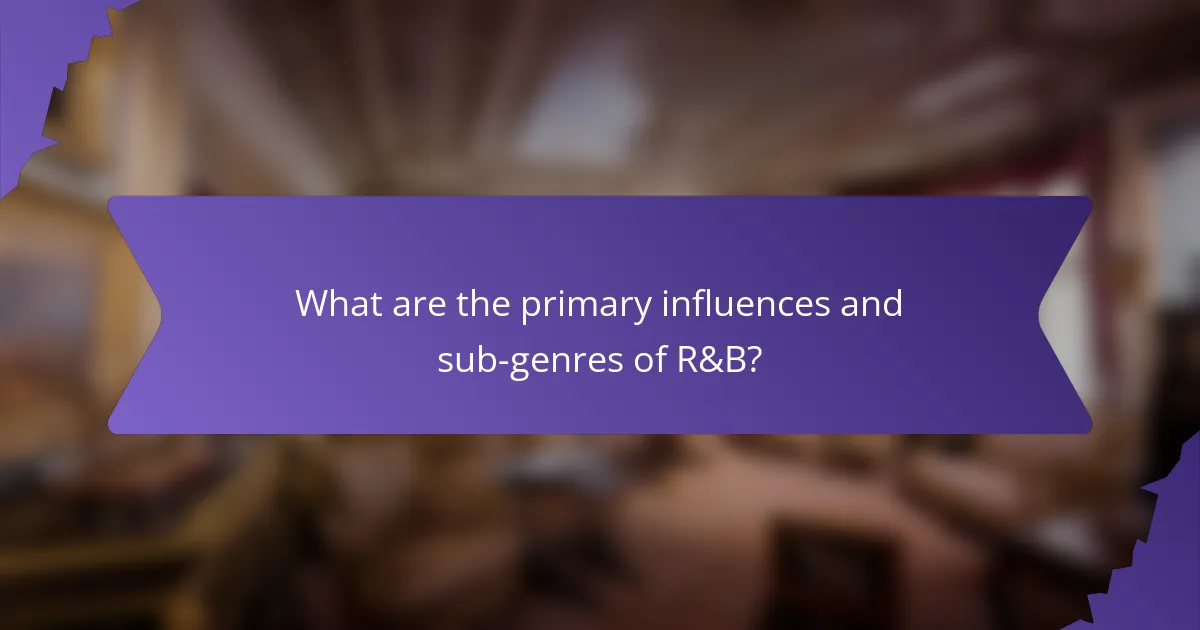
What are the primary influences and sub-genres of R&B?
R&B is influenced by various genres, including soul, funk, hip-hop, and pop. Key sub-genres include contemporary R&B, neo-soul, and alternative R&B. Contemporary R&B blends modern production with traditional elements, while neo-soul emphasizes a more organic sound. Alternative R&B often incorporates experimental sounds and diverse influences, showcasing the genre’s adaptability. This evolution reflects R&B’s unique ability to intersect with other musical styles, creating a rich tapestry of sound.
How does R&B intersect with soul and funk?
R&B intersects with soul and funk through shared rhythms, vocal styles, and emotional depth. R&B evolved from these genres, incorporating their elements while introducing new influences. Key artists like Ray Charles and Aretha Franklin blended soulful melodies with rhythmic grooves, creating a unique sound. This fusion has led to diverse subgenres, expanding R&B’s reach and impact in music.
Which elements of pop and electronic music are present in modern R&B?
Modern R&B incorporates elements of pop and electronic music through catchy hooks, synthesized sounds, and rhythmic beats. Artists blend genres to create a unique sound that appeals to diverse audiences. The use of electronic production techniques, such as auto-tune and digital effects, enhances vocal performances and adds depth to the music. Collaborations with pop and electronic artists further enrich the genre, showcasing its versatility and evolution.
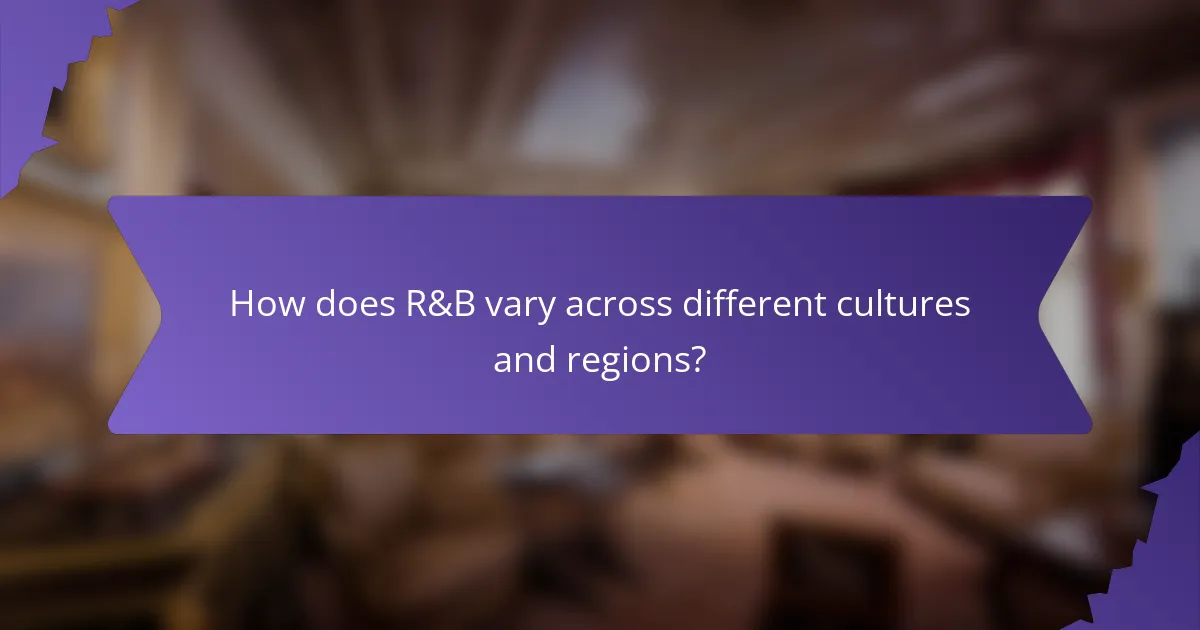
How does R&B vary across different cultures and regions?
R&B varies across cultures and regions through unique influences, instrumentation, and lyrical themes. In the United States, R&B blends elements of gospel and blues, focusing on emotional expression. In the UK, artists incorporate electronic sounds and diverse genres, leading to a distinct British R&B style. African and Caribbean influences introduce rhythmic variations and cultural storytelling, enriching the genre globally. Each region’s interpretation of R&B reflects its social context and musical heritage, resulting in a rich tapestry of sounds and styles.
What unique styles of R&B are found in the UK?
UK R&B features unique styles such as UK garage, grime-influenced R&B, and neo-soul. These styles blend traditional R&B elements with local music influences. UK garage incorporates fast beats and syncopation, while grime adds a raw, urban edge. Neo-soul focuses on smooth melodies and introspective lyrics, showcasing the diversity within the UK R&B scene.
How does Latin influence manifest in R&B music?
Latin influence manifests in R&B music through rhythmic patterns, melodic structures, and instrumentation. Artists like Beyoncé and Marc Anthony blend Latin elements, creating a fusion that enhances emotional expression. The incorporation of Latin rhythms, such as salsa and bossa nova, adds a unique texture to R&B, making it more vibrant and diverse. Collaborations between R&B and Latin artists have become more common, showcasing this genre-blending trend. This evolution reflects a broader cultural exchange, enriching both R&B and Latin music landscapes.
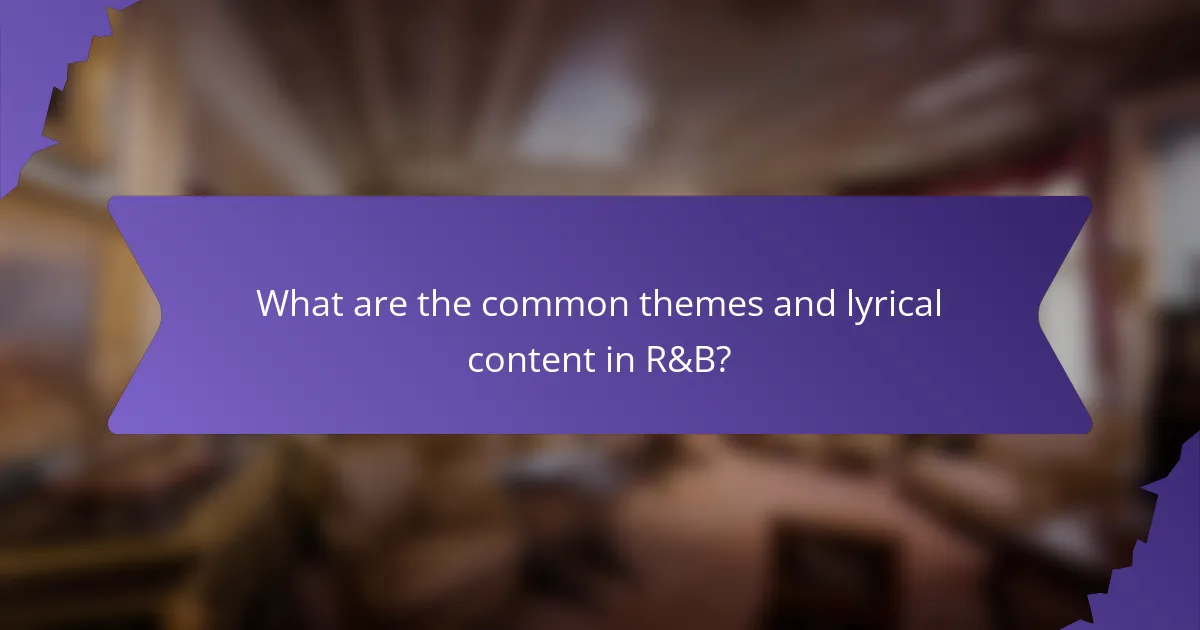
What are the common themes and lyrical content in R&B?
R&B commonly explores themes of love, heartbreak, and empowerment through emotional storytelling. Lyrical content often reflects personal experiences, social issues, and cultural identity. The genre blends elements from pop, hip-hop, and soul, enriching its narrative depth. Key figures like Marvin Gaye and Beyoncé have shaped its evolution, while contemporary artists continue to innovate within these themes.
How do love and heartbreak shape R&B narratives?
Love and heartbreak profoundly shape R&B narratives, driving emotional depth and relatability. These themes often manifest in lyrics that explore vulnerability, longing, and resilience. Artists like Marvin Gaye and Beyoncé exemplify this evolution, using personal experiences to connect with listeners. The genre blends elements from soul, hip-hop, and pop, further enriching its storytelling capabilities. R&B’s focus on emotional authenticity allows it to resonate deeply, making love and heartbreak central to its identity.
What role does social commentary play in R&B lyrics?
Social commentary plays a crucial role in R&B lyrics by addressing social issues and personal experiences. This genre often reflects the struggles and triumphs of marginalised communities, providing a voice to their realities. Artists like Marvin Gaye and Billie Holiday used their music to comment on social injustices, influencing the genre’s evolution. The unique attribute of R&B lies in its ability to blend personal narratives with broader societal themes, making it a powerful medium for change. As a result, R&B not only entertains but also educates listeners about critical social issues.
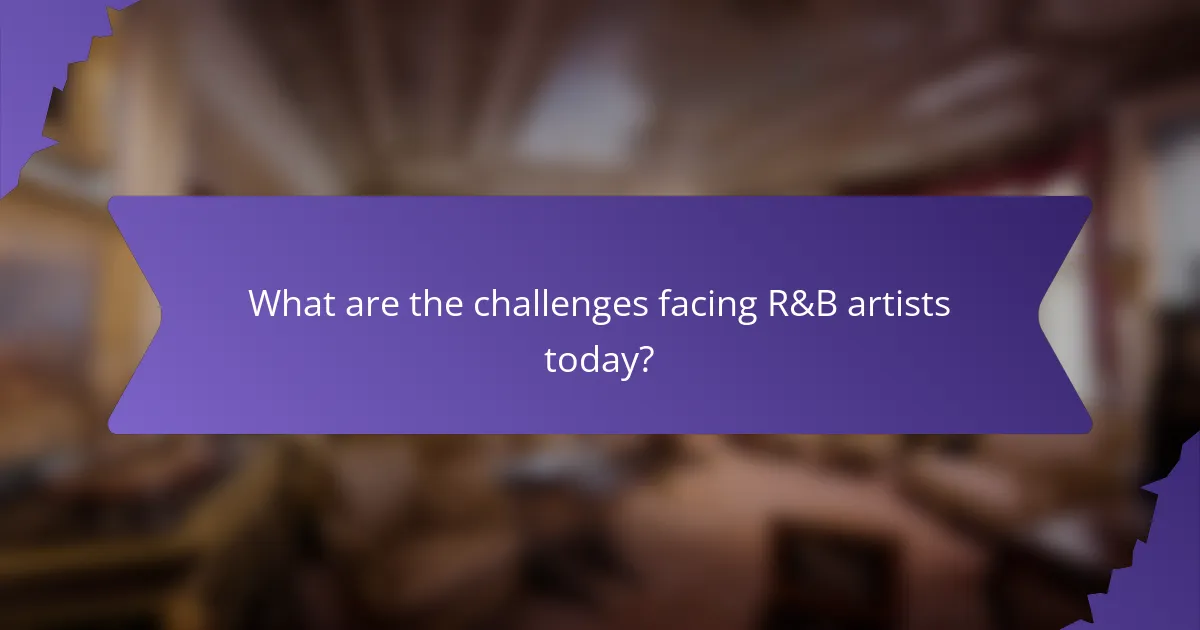
What are the challenges facing R&B artists today?
R&B artists today face numerous challenges, including industry competition, streaming economics, and cultural shifts. The rise of digital platforms has intensified competition, making it harder for individual artists to stand out. Additionally, streaming services often favour mainstream hits, impacting revenue for emerging talents. Cultural shifts also influence R&B, as genre blending creates both opportunities and challenges in maintaining authenticity. These factors collectively shape the landscape for R&B musicians, requiring adaptability and innovation.
How do streaming platforms affect the distribution of R&B music?
Streaming platforms significantly enhance the distribution of R&B music by providing global access and personalised recommendations. They allow artists to reach wider audiences without traditional barriers. Data shows that streaming has increased R&B listenership, with platforms like Spotify and Apple Music curating playlists that promote emerging talent. This democratisation of music distribution fosters genre blending, as artists collaborate across styles, further evolving R&B’s sound. Consequently, the influence of streaming reshapes how R&B is consumed and appreciated worldwide.
What are the common pitfalls for emerging R&B artists?
Emerging R&B artists often face pitfalls such as lack of market understanding, inadequate branding, and insufficient networking. Many struggle with genre blending, leading to identity confusion. Additionally, failing to invest in professional production can hinder their sound quality. Lastly, neglecting audience engagement limits their growth potential.
How can R&B artists maintain authenticity in a commercial landscape?
R&B artists can maintain authenticity by staying true to their roots while embracing innovation. They can achieve this by blending traditional elements with contemporary influences. Authentic storytelling remains vital, allowing artists to connect deeply with their audience. Collaboration with diverse artists can also enhance their sound without compromising integrity.
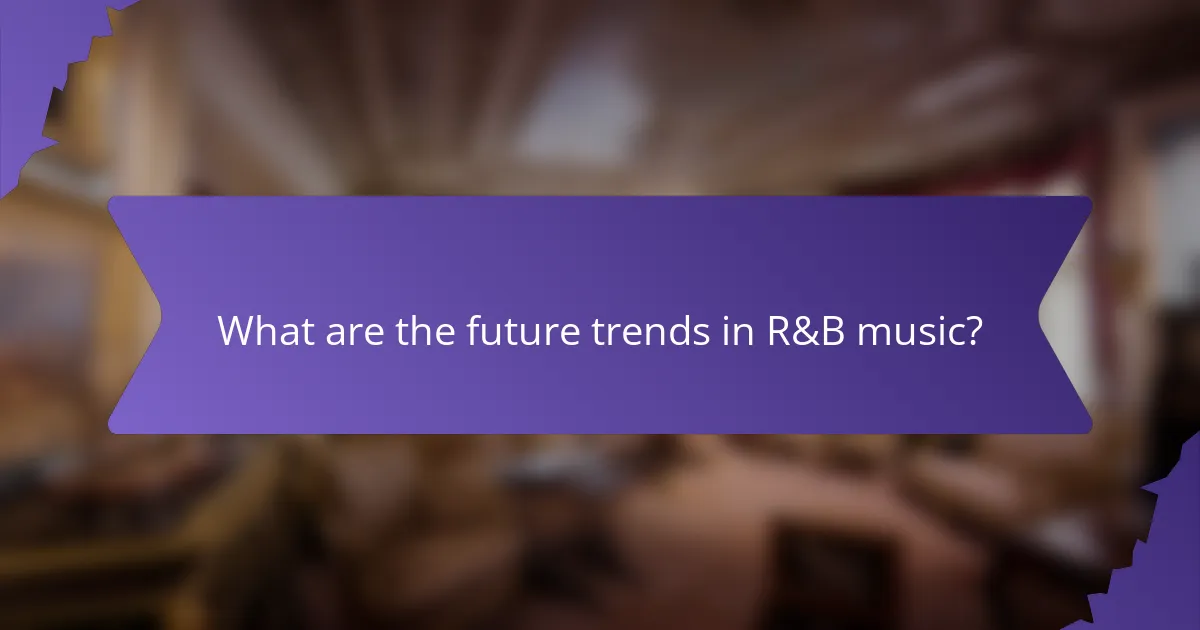
What are the future trends in R&B music?
R&B music is evolving with trends like genre blending, increased digital accessibility, and diverse collaborations. Artists are fusing R&B with hip-hop, pop, and electronic music, creating innovative sounds. The rise of streaming platforms enables wider audience reach, influencing production styles and marketing strategies. Unique attributes include the integration of social issues in lyrics, reflecting contemporary culture. As a result, R&B continues to adapt, attracting new generations while honouring its roots.
How is technology shaping the sound of R&B?
Technology is significantly shaping the sound of R&B by introducing innovative production techniques and diverse influences. Digital audio workstations allow artists to experiment with unique sounds and collaborate remotely. The rise of streaming platforms has also transformed how R&B is consumed, enabling genre blending and cross-pollination with hip-hop and electronic music. Additionally, advancements in sound engineering, such as auto-tune and sampling, have redefined vocal styles and instrumentation, creating a modern R&B sound that resonates with a broader audience.
Which collaborations are likely to influence the next generation of R&B?
Collaborations between emerging artists and established R&B figures will significantly shape the genre’s future. Notable partnerships like SZA with Travis Scott and H.E.R. with Chris Brown are already blending styles and expanding audiences. These collaborations often introduce innovative sounds and diverse influences, pushing R&B into new territories. As artists continue to experiment, the genre will evolve, reflecting a fusion of contemporary trends and traditional elements.
What practices can R&B artists adopt to stay relevant?
R&B artists can stay relevant by embracing genre blending, engaging with social media, and collaborating with diverse artists. They should also focus on authentic storytelling in their music. Regularly evolving their sound and connecting with younger audiences can enhance their appeal.